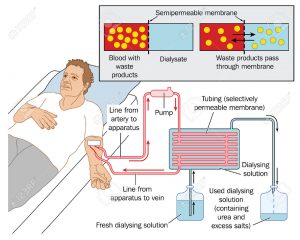Haemodialysis is a technique that replaces the main functions of the kidney, bypassing the blood through a biocompatible artificial filter (functioning as an artificial kidney) in which it is purified, returning the patient free of impurities.
Haemodialysis is the treatment option for kidney failure that is done by passing it through an external filter that is in a dialysis machine. This filter allows toxins and excess fluid to leave the blood, thus replacing the function of your diseased kidneys.
Venous access
To carry out the hemodialysis, it is necessary to have a vein of a large caliber (called a fistula) that will serve to puncture the 2 needles through which the blood will come and go. It is done by a small surgical intervention, usually in the non-dominant arm or in one with better veins, in which an artery is attached to a vein that, over time, will thicken its wall and its caliber when receiving blood at a higher rate. Pressure.
This fistula must be planned with a minimum of 3-6 months, the time necessary for its proper development and maturation. When there are bad veins or they have been exhausted by previous fistulas, a tube is placed between the artery and the vein of a special material (Goretex) and that is where it is punctured. It is very important that if your future dialysis option is hemodialysis, protect the main veins of your arms as much as possible for future fistulas; blood tests should be drawn from veins in the back of the hand and arm.
If the renal insufficiency is acute or there has been a rapid worsening of chronic renal failure, it is necessary to resort to the placement of a temporary catheter in a thick femoral or jugular vein, which carries the risk of infections and thrombosis that can complicate the functioning of future fistulas. Its placement and use are immediate.
If a temporary catheter is expected to last longer than 3-4 weeks, it is recommended to place a permanent catheter, which due to its material and its subcutaneous route, presents fewer complications and can be maintained much longer. Its placement is relatively simple and requires care by both the patient and the healthcare staff. In any case, the permanent catheter should never be a long-term option, unless it is impossible to make a fistula.
The dialysis filters
The dialysis filter is the place where blood is cleared in hemodialysis. It is a plastic cartridge that contains thousands of hollow filaments through which the blood passes and which are surrounded by the dialysis fluid into which all the debris that comes out of the blood is poured. This filter is discarded together with the rest of the material after each session.
Haemodialysis modalities
- Hospital
- Domiciliary
In both cases, the treatment is intermittent and therefore allows the accumulation of toxic substances and fluid between dialysis and dialysis, so it is necessary to maintain some restrictions of diet and fluids.
The hospital hemodialysis is performed in hospital units or dialysis centre in Delhi, usually performed 3 times a week with an average duration of 4 hours, in shifts on Tuesday, Thursday and Saturday or Monday, Wednesday and Friday and at fixed times morning or afternoon. In this case, the dialysis is carried out by the healthcare staff, with whom the patient maintains close contact, as well as with the rest of the patients. The patient maintains a passive attitude during the treatment but must comply with the dietary and medication recommendations.
The home hemodialysis, which is enhanced in the home after training in the hospital 1-2 months. It only goes to the Hospital for reviews and tests every 2-3 months. At home, there must be enough space for the dialysis machine and the necessary equipment, and there must be a trained collaborator (usually a relative) who must remain at home while he is on dialysis.
Contact phone is always available 24 hours a day. This option allows the patient freedom of time, offers the possibility of being able to perform it more frequently (3 to 6 times a week), although of shorter duration, and facilitates the reconciliation of treatment with social and work life.
By being able to do it more frequently, important accumulations of toxins are avoided, it is more physiological, and it requires fewer restrictions in the diet. Obviously, it is necessary that both the patient, the companion, and the home meet certain requirements that guarantee adequate treatment.


